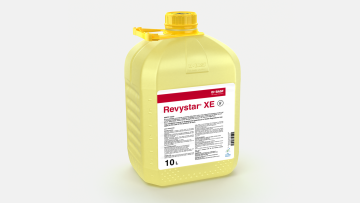RevYstories: Tim Lamyman
13.06.2022

Tim's RevYstory
There are farmers whose names are synonymous with high yielding wheat crops – Mike Solari, Eric Watson and Tim Lamyman. Mike and Eric farm in New Zealand, where their soils are deep in a country that routinely irrigates its cereal crops. In sharp contrast, Tim farms Worlaby Farm on the Lincolnshire Wolds near Horncastle.
Worlaby spans 600ha (1,500 acres) of which 550 acres is under arable production, Tim’s philosophy is that he needs to maximise his return from his cropping land and that attention to detail is central to his approach.
His soils can be challenging but investing time and money into soil health aids his decades of high yield achievements, not only in his wheat crops (world record of 16.5t/ha in 2015), but also in pea crops (6.47t/ha in 2017) and oilseed rape (7.01t/ha in 2018).
Despite an horrendous season culminating in the 2020 harvest, Tim won both the silver and Gold medals in the 2020 Yield Enhancement Network (YEN), the varieties KWS Parkin and KWS Colosseum, yielding 15.4t/ha and 15.6t/ha respectively.
Tim’s ‘no stone unturned’ approach has served him well, he says, despite last year’s awful combination of a wet autumn and spring drought. The crops were drilled on 23rd September at a seed rate of 175kg/ha. Three autumn applications of NHK Delta – N + K fertiliser – were applied in the autumn.
In the spring, small, split doses of N, micronutrients and a meticulous fungicide programme paid dividends.
Supported by his Frontier agronomists, Jeremy Nicholson and Ben Mead, BASF and BioNature UK, Tim suggested that it was the combination of strong rooting, ear numbers and sustained green leaf area that delivered the result.
An assessment of the crop in February 2020 showed root penetration to 30cm deep which Tim said was so important given their record rainfall of 660mm from 1st September 2019 to 1st March 2020.
Total applied nitrogen 358kg/ha – the rate was set to drive the yield potential – it was applied in five splits of 52kg/ha, 54kg/ha and three splits of 84kg/ha. In addition, foliar applications of Tip Top, a micronutrient complex containing nitrogen, phosphorus (as P2O5), potassium (as K2O), magnesium, boron, cobalt, copper, iron, manganese, molybdenum and zinc.
Nutrition and fungicides have been key to keeping the established crops greener for longer.
Disease levels were low during the spring of 2020; however, Tim maintained his robust five-spray fungicide programmes based on Revystar ® XE at T1 and Myresa® + Syrex® at T2: “the combination of the newest fungicide on the market and the best strobilurin gave us probably the cleanest crop we have had in years and was fantastic for yellow rust control and maintaining green leaf” said Tim.
Jeremy said that the fungicide programme was developed with great care and using all the data available – current crop, varietal traits, dose response and the products’ technical performance. “We also based programme decisions on the YEN information, in-season crop biomass and visual crop inspection.
“Based on this information we intentionally applied Revystar ® XE at T1 for Septoria and saved the Myresa® + Syrex® for the T2 position for green leaf area development and duration; we also felt that these would be most beneficial; saving the pyraclostrobin to give the longevity to the rust control that is needed on the Wolds’ soils which, he said, are prone to late brown rust infections. PGR rates have been “frighteningly low” and added at repeat timings. “We were enormously impressed with the way the programme has performed; we had a crop that was still clean from top to bottom at the end of July.”
Tim added: “The programme has helped us come through a very tough season. The combination of the newest and best fungicide on the market and the best strobilurin gave us complete control all season, and probably the cleanest crop we have had in years, including excellent floret and grain sets of 70-80 grains per ear average. There was a definite benefit from the prolonged greening and trying the programme that we have in the field, has convinced us that it’s been the way to go to deliver yield.
He added that “the prolonged greening was probably from the BioNature programme and best greening products on the fungicide market.”
Tim used older azole chemistry at T3 and T4 for fusarium and brown rust control. The fungicide combination, he said, created a ‘greener for longer’ crop, which drove the YEN-winning yields.
Looking to the 2020/21 crop, Tim hopes that the partnership will take him into a new era of yield. The current crop is looking very well, and the plans are to follow the main elements of the YEN-winning programme he used last year. Who knows? Maybe we will have the wheat yield world championship returning to the UK for 2021.

